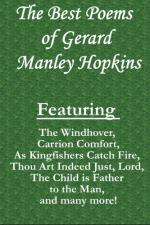
|
| Name: _________________________ | Period: ___________________ |
This test consists of 5 multiple choice questions, 5 short answer questions, and 10 short essay questions.
Multiple Choice Questions
1. In lines 5 and 6, what is the bird's motion compared to?
(a) An ice skater.
(b) An arrow.
(c) A swing.
(d) A ball being thrown.
2. What technique is employed in the line 9 phrase "oh, air, pride, plume, here"?
(a) Antithesis.
(b) Anaphora.
(c) Atanaclasis.
(d) Asyndeton.
3. In lines 10 and 11, the speaker says that the fire "that breaks from thee" is a billion times "lovelier" and more what?
(a) Dangerous.
(b) Sanctified.
(c) Rapturous.
(d) Hypnotic.
4. What is the bird the "dauphin" of (line 2)?
(a) Daylight.
(b) The dawn.
(c) The air.
(d) Flight.
5. What type of rhyme is seen in the poem's "B" lines"?
(a) Slant.
(b) Eye.
(c) Masculine.
(d) Feminine.
Short Answer Questions
1. What is the common name of the titular bird?
2. What does the word "wimpling" literally mean in the context of line 4?
3. Who is being referred to in line 10's "thee"?
4. What would it mean to have "Rebuffed the big wind" (line 7)?
5. To whom is the poem dedicated?
Short Essay Questions
1. What is a "windhover," and what characteristic of its flight is focused on in this poem?
2. What Christian paradox is expressed when the speaker refers to the bird as both a "minion" and a "dauphin" (lines 1-2)?
3. In "The Windhover," who is speaking, and what moves him to speak?
4. What makes a creature like the windhover an appropriate symbol for Christ?
5. What are the literal and figurative meanings of the poem's references to a "dauphin" and a "chevalier"?
6. What is the relationship of the expression "in his riding/ Of the rolling level underneath him steady air" (lines 2-3) to the later reference to "the rein of a wimpling wing" (line 4)?
7. Describe the relationship of the content in the poem's final six lines to the content in lines 1-8.
8. How do the images in the last three lines support the idea that there is "no wonder" in the kestrel's fight (line 9)?
9. What is the meaning of the simile contained in lines 6 and 7: " As a skate's heel sweeps smooth on a bow-bend: the hurl and gliding/ Rebuffed the big wind"?
10. Describe the poetic form of "The Windhover."
|
This section contains 886 words (approx. 3 pages at 300 words per page) |

|




